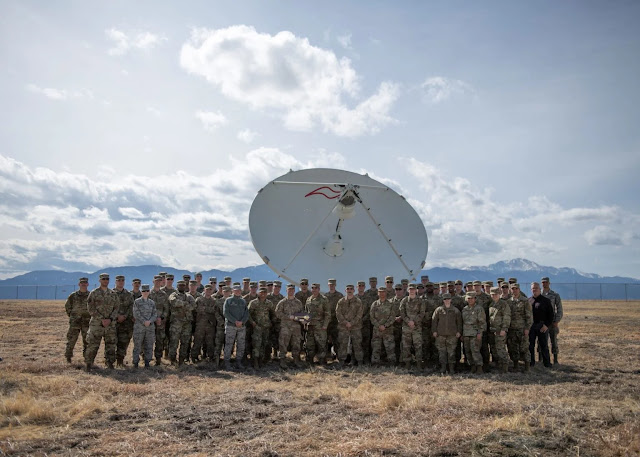This space-based weapon remains in the dark—for now
Only so many secrets can be kept in space. A space weapon that is currently in orbit would have been shown this week, if all had gone according to plan for General John Hyten, vice chair of the Joint Chiefs of Staff. According to Breaking Defense, Hyten had wanted to reveal a classified space weapon program during the 2021 Space Symposium meeting.
The announcement was apparently initially scheduled for last year's Space Symposium but was postponed due to a pandemic. This time, it was delayed due to the abrupt conclusion of coordinated operations against the Taliban.
The declassification of the weapon was initially intended to mark the successful launch of the Space Force, which gave the Pentagon access to weapons in space in addition to a new branch. Three important, scary concerns still need to be answered after the timeframe was once again pushed back: why would the military desire an anti-satellite weapon, why deploy it in space, and what threats would such a weapon pose?
Why use a weapon against satellites?
Military V-2 rockets were the first items created by humans to cross the Kármán Line (100 km above the earth) and enter space. This first foray into human space activities, especially in orbit, was a military undertaking. The intercontinental ballistic missiles, which are the offspring of the older V-2s, are made to launch thermonuclear warheads into space before making a disastrous impact on Earth.
The other significant military device in space is satellites. Satellites that are in orbit park their sensors there and provide data to ground personnel. In 1960, the US launched a satellite equipped with a camera that could eject film canisters containing private information to the planet's surface. The US deployed a satellite with a hidden mission to monitor radar signals coming from the USSR that same year. The USSR quickly did the same. Both superpowers utilized satellites in orbit to monitor their respective military on the ground as this satellite race remained centered on surveillance.
Nations construct and transport weapons below, and place sensors in orbit to offer early warning of anything from land invasion to nuclear launches. This has been a precarious line for decades.
This risk stems from the reliance on sensors in orbit. If the satellite monitoring such movements was likewise compromised or destroyed, a nation's capacity to detect an assault in real time may be shattered. Several countries have shown off their capacity to shoot down satellites using ground-based missiles. Anti-satellite jammers and other Earth-based technologies are more widely categorized as weapons.
Why in space?
It's been done before to place an anti-satellite weapon in orbit. The Soviet Union even integrated a large cannon into a space station in the 1970s and conducted an orbital test firing of it. The US started working on a specialized anti-satellite weapon in the 1970s.
A military may wish to conceal a weapon in a satellite for a very good reason—it may be ready for use when it has to launch an assault.
This type of satellite and others already exist. The inspection robot Shijan-17 from China can maneuver in orbit to fix other satellites and alter their courses. Future robot tentacle arms designed for trash clearance might potentially be deployed to lash out against and damage other satellites.
What hazards exist?
The risk of putting weapons in orbit is considerable, especially if other countries are aware of them. Right now, orbit benefits all countries that have satellites by enabling such spacecraft to see the Earth below unimpeded. Instead, if every satellite was a potential weapon, it may lead countries to launch satellite attacks on one another out of concern for any assets already launched into orbit.
A range of negative effects might result from violence in orbit. Broken satellites create orbital debris, which has a considerably higher force than a bullet and may accelerate and pierce other spacecraft. As the debris cloud accumulates and more satellites disintegrate, the once-useful region of space will eventually become a burned orbit. If debris from one damaged satellite damages another satellite, the risk to every other item in space increases exponentially.
This has ramifications that go beyond space conflict. Additionally, it makes it more difficult for countries to comprehend and prepare for nuclear assaults. It will likely be advantageous to whomever attacks first if governments determine that satellites are fair game for military attacks, even though it runs the danger of a nuclear error below. One government's disclosure of a weapon in orbit signals to every other country not only that it considers satellites to be legitimate targets but also that an offensive war against satellites would be possible.
Hyten is ready to expose whatever space weapon the US possesses, but hyping it without disclosing the weapon is probably the worst of all worlds. If the weapon had remained undiscovered, it would only have affected the strategic planning of other nations that could have learned of its existence. If it was made public, it may act as a deterrent to additional space weapons since governments would be directly threatened with retribution. It is difficult for governments to adapt their response based on reality when the weapon is partially public and partially private, which is a prescription for failure and maybe disaster.




Comments
Post a Comment